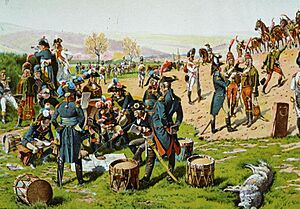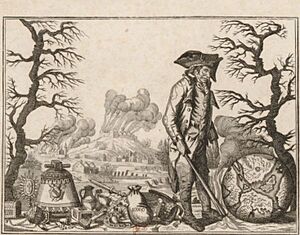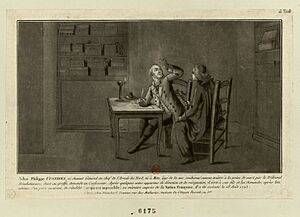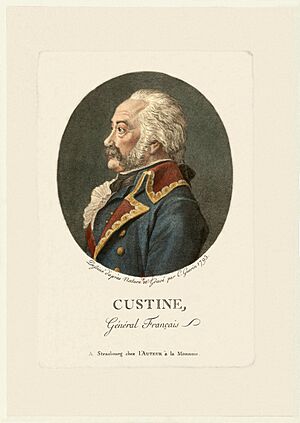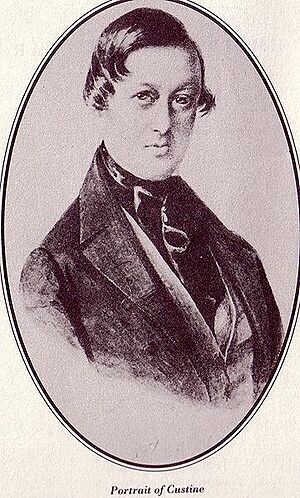Adam Philippe, Comte de Custine facts for kids
Quick facts for kids
Adam Philippe, Comte de Custine
|
|
|---|---|
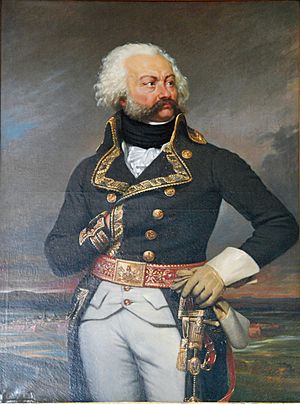
Custine as general-in-chief of the Army of the Rhine in 1792 (painted posthumously in 1834)
|
|
| Born | 4 February 1740 Metz |
| Died | 28 August 1793 (aged 53) Paris |
| Allegiance | |
| Service/ |
French Army |
| Years of service |
|
| Rank | General |
| Battles/wars | |
| Awards |
|
| Other work |
|
Adam Philippe, Comte de Custine (born 4 February 1740 – died 28 August 1793) was a French general. He was an important military leader during a time of big changes in France. He fought in several major wars, including the American Revolutionary War.
As a young officer, Custine served in the Seven Years' War. Later, he helped the American colonists fight for their independence. He was part of a special French army sent to support them. After a big victory at Yorktown, he went back to France.
When the French Revolution started, Custine became a political leader. He was chosen to be part of the Estates-General. This was a meeting where people from different parts of France discussed the country's future. He supported some new laws but also believed in the king's power.
In 1791, he returned to the army as a high-ranking general. He led successful campaigns in the Rhine region in 1792. His troops captured important cities like Speyer and Mainz. However, things changed quickly during the Revolution.
Custine faced accusations of not being loyal to the new government. Even though he was defended by Maximillien Robespierre at first, he was later arrested. He was put on trial and found guilty of treason. He was executed by guillotine in Paris in 1793. His family also suffered during this time.
Contents
Military Service: A General's Journey
Adam Philippe de Custine had a long and interesting military career. He started serving in the army when he was very young. His experiences helped him become a skilled leader.
Early Years in the Army
Custine began his military life at just eight years old in 1748. He learned from famous generals like Marshal Saxe. During the Seven Years' War (1756–1763), he fought in the French army in Germany. He was a captain of dragoons, a type of soldier on horseback.
Fighting against the Prussians, Custine admired their strong military organization. This experience later influenced how he led his own troops. By the end of the war, he was a high-ranking officer.
Helping America Win Independence
Custine wanted more military action and experience. So, he joined a regiment heading to America. In April 1780, his regiment sailed to the Thirteen Colonies. There, he fought bravely against the British.
He was a colonel in the French forces led by Count Rochambeau. Custine's regiment played a key role in the Yorktown campaign in 1781. They received special praise for their actions at the Battle of Yorktown. Custine himself was recognized for his courage and talent.
Custine was in charge of the French troops who started the first attack at Yorktown. He also helped lead other operations. After the British surrendered, Custine's regiment spent the winter in Williamsburg, Virginia. Then, they left for the Caribbean. When he returned to France, Custine was promoted to brigadier general. He was also made governor of Toulon.
Custine's Role in the French Revolution
The French Revolution brought big changes to France. Custine played a part in both the political and military sides of this historic event.
Serving in the National Assembly
In 1789, people from Metz chose Custine to represent them in the Estates-General. This was a major political body. He resigned from the army to focus on his new duties.
As the Revolution grew, Custine stayed in the National Constituent Assembly. He supported creating a constitution for France. He often voted with other liberal nobles, like the Marquis de Lafayette. While he agreed to end some old noble rights, he also defended the king's power. He also supported the rights of nobles who had fled France.
Leading Armies in the Revolution
After the Assembly ended in 1791, Custine rejoined the army. He became a lieutenant general in the Army of the Vosges. Soldiers liked him, even though he was very strict. They called him "général moustache" (General Moustache).
The next year, he became the commander-in-chief of the army. In 1792, he led successful campaigns in the Rhine region. His troops captured Speyer, Worms, Mainz, and Frankfurt. He also brought the ideas of the Revolution to these German areas. He made nobles and clergy pay heavy taxes.
During the winter, a Prussian army forced him to retreat. He had to leave Frankfurt and move back across the Rhine. Around this time, another general, Charles François Dumouriez, was suspected of treason. Custine was called to Paris to explain his actions. He was accused of treason, but Robespierre defended him. Robespierre said Custine was an honest man who served his country well. Because of this defense, Custine was cleared of all charges. He was then given command of the Army of the North.
In May 1793, Custine planned to trap some enemy forces near Mainz. However, his plans faced difficulties. A French battalion accidentally fired on his own dragoons. Custine was very upset by this mistake. He said, "This day, which ought to have so memorable, terminated by the taking of one piece of cannon and a very great number of prisoners." He was recalled to Paris on 15 July.
Trial and Execution
When Custine arrived in Paris, he seemed calm and confident. He visited his family and went to public places. People cheered for him, shouting Vive Custine! (Long live Custine!). However, the government was watching him closely.
On 22 July, he was arrested and put in prison. Soon after, news came that Mainz and Valenciennes had been lost. These were cities Custine's army had controlled. The public prosecutor, Antoine Quentin Fouquier-Tinville, accused Custine of negligence. This meant he was blamed for allowing the enemy to take these important places.
During his trial, a newspaper called Père Duchene kept attacking Custine. This time, Robespierre did not defend him. Custine's daughter-in-law came to the courthouse every day to support him. On 27 August 1793, the Revolutionary Tribunal found him guilty of treason. He was executed by guillotine the very next day.
Custine's Character and Leadership
Even though he was accused of treason, Custine was known as a strong leader. He had a unique style that made his soldiers respect him.
Custine admired the Prussian army's strict training. He was a very strict disciplinarian himself. But his soldiers actually liked him and felt inspired by him. Custine often gave speeches and tried to know his soldiers by name. He visited them in the hospital and had a good sense of humor. His quick wit was famous among his troops.
However, he did not tolerate disorder or disobedience. Once, when some volunteers bragged about teaching the army how to be "Republican," he quickly disarmed them.
Custine was also good at finding talented officers. He recruited people like Louis Desaix and Jean-Baptiste Kléber for his staff. He even found a young officer named Laurent Gouvion, who later became Laurent de Gouvion Saint-Cyr. Custine saw Gouvion sketching enemy positions and was so impressed that he added him to his staff.
One of Custine's staff officers, Simon François Gay de Vernon, wrote that Custine cared for his soldiers. He was a good manager, generous, and understood military situations quickly. Custine valued smart advice from his officers.
However, Custine also had some flaws. He was very proud and sometimes didn't see the problems in his own plans. He also had a bad habit of blaming and criticizing other generals. For example, he said that another general, Jean Nicolas Houchard, couldn't handle leading two armies. This comment hurt Houchard, who had served Custine loyally. Custine also argued with other important military figures.
Custine's Family Life
Adam Philippe de Custine came from a noble family. His family also faced many challenges during the French Revolution.
Custine was born in Metz on 4 February 1740. His father, the tenth count, died in battle in 1757. Custine inherited other titles and properties, including a factory in Niderviller. He married Adelaide-Celeste Louise Gagnat de Longny.
In 1790, Custine's daughter married Henri Evrard, marquis de Dreux-Brézé. Her husband was a master of ceremonies for King Louis XVI. During the early 1790s, they lived as refugees in Britain.
Custine's son, Renaud-Louis-Philippe-Francois (born 1768), was also a military officer. He was a captain in his father's army. He had traveled widely and studied military art. He also served as a diplomat in Berlin.
Because they were noble and held important positions, Custine and his son became targets during the Revolution. In 1792, his son was suspected of being a royalist. He was worried about being arrested.
After his father's arrest, young Custine was also put on a list of suspected royalists. The main evidence against him was a letter he wrote to his father. In it, he suggested his father resign from the army. This letter, along with others, led to his conviction. He was executed on 3 January 1794, just a few months after his father.
His son left behind a young son, Astolphe-Louis-Léonor. Astolphe later became a famous travel writer. Custine's daughter-in-law, Delphine de Custine, was also imprisoned. She was released in 1794 and managed to get some family property back. She later moved to Germany and Switzerland with her son.
Niderviller Faience Factory
In 1770, Custine bought a faience factory in Niderviller. Faience is a type of pottery. The factory had been open since 1735 but wasn't making much money. It had faced problems, including a fire.
When Custine bought it, the factory was struggling. He had financial difficulties for several years. Later, he partnered with François-Henri Lenfrey. The factory then started making tableware in the English style. Lenfrey also improved how the pottery was made.
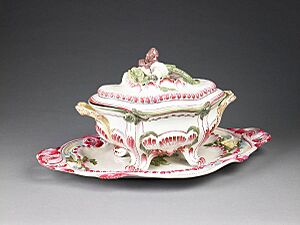
After Custine's execution, the government took his property. The factory temporarily closed, and workers lost their jobs. Many workers went to Paris to find work and even signed a petition for his daughter-in-law's release. The factory survived, however, and became successful again later. Custine even gave a set of this tableware to George Washington in 1782.
|


